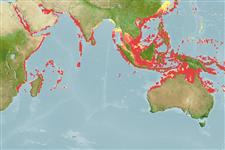Classification / Names
Common names from other countries
Main reference
Size / Weight / Age
Max length : 80.0 cm TL male/unsexed; (Ref. 48635); common length : 40.0 cm TL male/unsexed; (Ref. 2295); max. published weight: 4.9 kg (Ref. 40637)
Length at first maturity
Lm 29.1 range ? - ? cm
Environment
Marine; reef-associated; non-migratory; depth range 10 - 80 m (Ref. 2295)
Climate / Range
Tropical, preferred 28°C (Ref. 107945); 32°N - 23°S, 32°E - 160°E
Distribution
Indo-West Pacific: widespread, including the Red Sea, Arabian (Persian) Gulf, East Africa to Sri Lanka, to the Ryukyu Islands and Papua New Guinea. Also recorded from Micronesia (Ref. 3807) and French Polynesia (Ref. 4517) but these are probably misidentifications of Lethrinus olivaceus.
Countries | FAO areas | Ecosystems | Occurrences | Introductions
Short description
Dorsal
spines
(total): 10;
Dorsal
soft rays
(total): 9;
Anal
spines: 3;
Anal
soft rays: 8. The snout is moderately long, its dorsal profile slightly concave. Body color is bluish gray or brown often with scattered irregular dark blotches on sides; sometimes three dark streaks radiate forward from the eye. The fins are pale or orangish.
IUCN Red List Status (Ref. 115185)
Threat to humans
Reports of ciguatera poisoning (Ref. 31637)
Human uses
Fisheries: commercial
More information
ReferencesAquacultureAquaculture profileStrainsGeneticsAllele frequenciesHeritabilityDiseasesProcessingMass conversion
Tools
Special reports
Download XML
Internet sources
Estimates of some properties based on models
Phylogenetic diversity index
PD50 = 0.5000 many relatives (e.g. carps) 0.5 - 2.0 few relatives (e.g. lungfishes)
Trophic Level
3.8 ±0.53 se; Based on food items.
Resilience
Medium, minimum population doubling time 1.4 - 4.4 years (K=0.20)
Vulnerability
Moderate to high vulnerability (46 of 100)
Price category
